The goal of the Community Approach to 4 year old kindergarten is to achieve emotional, educational, societal, and medical well-being of all children. This approach blends funding of public and private resources to distribute learning programs and resources community-wide more efficiently, and offers many benefits to children, families, schools, and communities.
Click on the 4KCA benefit below to read excerpts from …. Bob Kann’s Report “54 Benefits…” and to see the results of our survey of community councils sharing the impact 4KCA has had in their community.
- Strengthens the school district’s ability to plan entrance into 5K.
- Improves preparation of children into public schools.
- Increases contact between school districts and parents of young children.
- Helps school districts understand the needs and challenges of early childhood programs.
- Improves the image of school districts.
- Increases efficient use of public funds by sharing space and resources.
- Reduces transportation costs.
- Increases accessibility of special services.
- Enables school districts to design unique programs that fit their communities.
37. The 4K Community Approach strengthens the school district’s ability to plan for the entrance of young children into the public schools.
 The
The 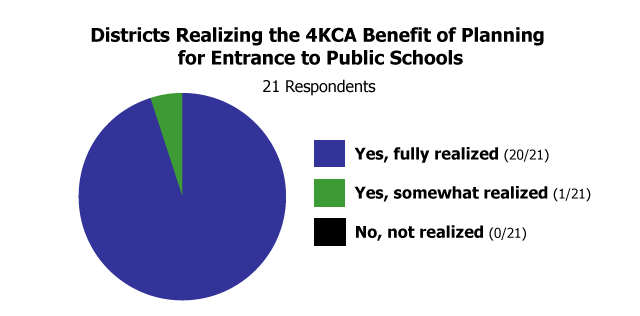 4K Community Approach program has opened new lines of communication between school district staff and staff in the community 4K settings. Experienced and knowledgeable child care teachers now share information about children they’ve sometimes known since birth with teachers of five-year-old kindergarten who will subsequently be teaching these same children. There are innumerable benefits resulting from such communications, including:
4K Community Approach program has opened new lines of communication between school district staff and staff in the community 4K settings. Experienced and knowledgeable child care teachers now share information about children they’ve sometimes known since birth with teachers of five-year-old kindergarten who will subsequently be teaching these same children. There are innumerable benefits resulting from such communications, including:
• The kindergarten teachers can learn from the child care teachers which practices and strategies previously worked and did not work with a particular child. This information can include both the child’s academic and social strengths and challenges.
• For children with special needs or those requiring some kind of therapy, the kindergarten teacher can better understand the types of supports they can provide to help the child best function and succeed.
• The kindergarten teachers can acquire valuable information from the child care teachers and providers about the new kindergartener’s family because they have unique perspectives to share as a result of often having so much contact with the families connected to their programs. Wraparound care often results in preschool children spending considerable time in a facility and hence provides child care staff innumerable opportunities to interact with both the children and their families.
Return to top
38. The 4K Community Approach improves the preparation of young children for entrance into the public schools.
Jennifer Skibba, Early Learning Coordinator, Verona Area School District talks about the improvement they have seen using 4KCA. Heather Cramer from Stevens Point and John Schlender from Mayville talk about 5 year olds being better prepared.
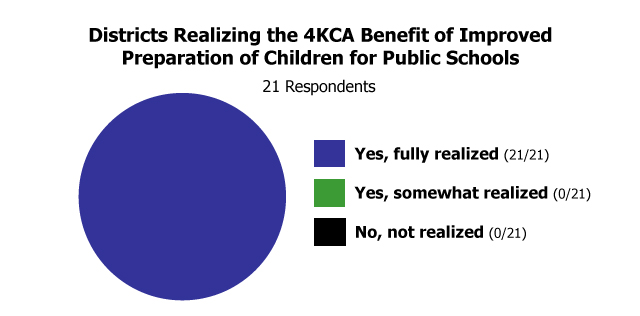
Some of the 4K Community Approach programs use the same curriculum that is used with older children in the public schools in their communities. The result is that when 4K children subsequently attend the public schools, they will already have experience and familiarity with the curricula that will continue to be part of their education in the future.
Garret Bresina, the owner of Kids USA Learning Center in Chippewa Falls, describes such a curriculum,
“The Pyramid Model for Developing Social and Emotional Intelligence is a social and emotional program. The school district uses it in all of their elementary, middle, and high schools. The curriculum is geared down for infant to age 5- the expectations, teaching “quiet hands,” and the tools we use for helping children help themselves with social problems. By the time they get to elementary school, it’s second hand to them. When younger children feel sad or when they are a little older and can understand what being frustrated means, they learn it’s OK to feel those emotions and have those feelings. All thirty-three members of our staff have had the twenty-four hours of training on the Pyramid Model. We’re now three years into it and we love it! We were doing things well before, but now we’re doing things even better.”
Return to top
39. The 4K Community Approach program increases the contact school districts have with parents of young children.
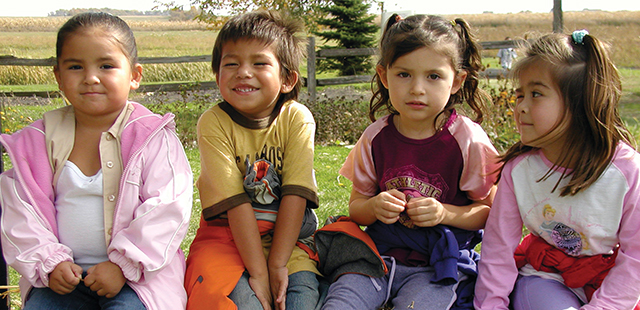
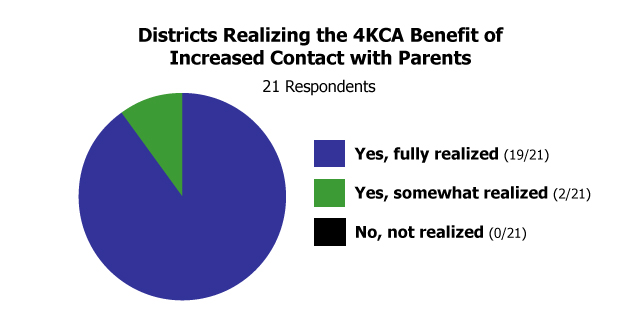
The 4K Community Approach programs have a strong parental outreach component. Parents are invited to attend educational programs, family activity events, and field trips. They receive informational emails and take-home literature from 4K teachers and meet with them periodically at parent-teacher conferences. The increased contact between 4K-CA program staff and parents has several benefits:
• School personnel often provide training sessions for parents. This provides parents with useful ideas for activities they can do with their children and provides school personnel additional contact with the parents, which enables them to better understand and work with the 4K children.
• Parents sometimes feel better about the way they’re parenting when they learn that there is educational value in many of the routines and chores they do daily with their children.
• 4K Community Approach programs commonly host Family Nights and events using community-based facilities, such as a Literacy Night at the public library, activity night at the YMCA, or a field trip to the school forest. These events increase contact between school staff and parents, which increases parents’ level of comfort and familiarity with the school staff and ultimately the school district.
• Special services staff from school districts now have a “presence” in the community 4K programs. This increases the contact they have with 4K children, younger children attending child care programs in the same facilities, and the parents of these children, which makes it easier for parents to consult with the school district staff regarding issues of concern with their children.
• Parents feel more trust in the schools because they have increased contact with school personnel in the community. This familiarity makes parents more comfortable when their children enter 5K in the schools because they’ve already communicated with staff from the school district.
Return to top
40. The 4K Community Approach program helps school districts gain a better understanding of the needs and challenges of the early childhood programs in their community..
What school districts have learned about child care using 4KCA is talked about by Barb Grabel from Madison and Jennifer Skibba from Verona.
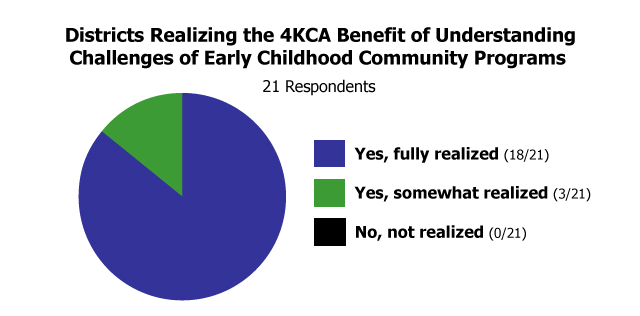
The 4K Community Approach program facilitates close collaboration between school districts and community partners. The school district benefits in a variety of ways, including gaining a better understanding of the needs and strengths of the early childhood programs in their communities. With this knowledge, school districts are more committed and better able to work cooperatively with their community partners to provide quality early learning for children.
Jennifer Trudell, 4K Coordinator for the Howard-Suamico School District, describes how the community partners gained a voice with the school district as a result of the 4K Community Approach program,
“{4K-CA} also helped the community sites have a voice back to the school district, and I mean that in a good way. Typically when a school district deals with child care sites, the district is looked to as the authority. It doesn’t mean that the district understands the day to day activities at the child care level, but they’ve got higher education and funding. With 4K, suddenly there were eleven of us saying ‘Hey, this is reality. This is what’s going on. This is what’s working well.’ Now the education was going both ways. It seemed like community sites had to unite to get that across well.”
Jennifer Trudell also explains how the schools are learning about funding issues that challenge the community sites,
“Funding is vastly different from the two perspectives. From the school’s perspective, funding comes from the state and federal authorities. Certainly there are budgets to be met, but generally it goes into one pot and you disperse as needed into different accounts within a school system. If one account gets low, additional resources can be moved from a different account to help compensate. In the child care centers, it’s on the backs of the parents directly. The tuition they pay is the only source of funding by which all bills are accounted for. There is no additional funding, with the exception being W-2 children, but often there are few of them involved and are reimbursed at the same rate as the other children. It’s a lot tighter and we’re responsible for much of the costs.”
Belinda Grantham, Director of Early Education for the Kenosha Public Schools, describes different ways the school district benefits from collaborating with the community sites,
“It allows us to have outreach with children that we would not be able to serve in a school setting because of the family’s needs for child care in many cases. It also allows families the opportunity to attend a location that might be actually closer than the school the child would be going to. Bottom line- we’re building stronger foundation pieces- both academic and social and emotional. All of them will be going to kindergarten programs, so we’re just getting them in advance. It’s also increasing awareness of our centers in our school. When the school teachers are reading about a student, the report is often from a center, so it increases their awareness that the centers are out there. … Personally, I’ve learned a lot more about child care than I knew before because of my conversations with the directors we work with. It’s building common understand acceptance for what’s happened.”
Return to top
41. The 4K Community Approach program improves the image of school districts in their communities.
Terri Goettl, Early Learning and Special Education, Eau Claire School District, shares the impact of 4KCA in her community
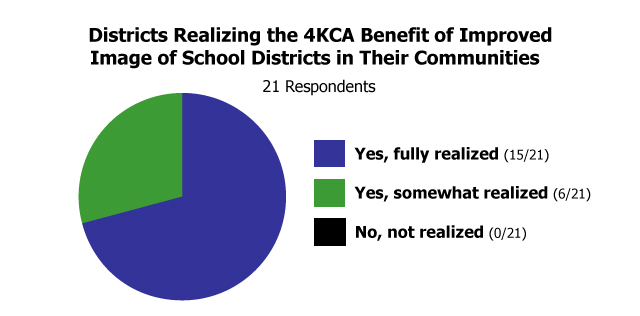
School districts have consistently improved their images in their communities when they’ve developed 4K Community Approach programs in a collaborative fashion. While many child care centers feared that the school districts would take a “top-down” approach to 4K Community Approach programs and tell them what to do, instead many school districts asked the community partners to describe their needs and the school districts then tried to meet those needs. By improving their overall image in the community as a result of the 4K Community Approach program, school districts’ increase the “buy-in” from their communities and hence are more likely to receive support when they are trying to raise funds through referendums.
Linda Gratz, Former Director of Head Start in Manitowoc explains,
“One of the biggest benefits in the community {of 4K-CA} is showing that the school district is willing to collaborate. It’s not just the school district telling them what to do all the time. That they’re actually working with the day cares, with the Head Start. There’s a feeling that we’re all in this together, and I think that’s done a lot as far as the school district image in the community of being one that’s for the common good. The initial wariness of child care and Head Start that the schools would eventually squeeze them out has passed and there’s more a sense of togetherness about the whole thing.”
Return to top
42. With 4K Community Approach, by using the space and resources available in the community programs, the school district can more efficiently use public funds..
Jennifer Trudell, 4K Coordinator, Howard-Suamico School District shares how using 4KCA helps a district use funds efficiently.

Although the impetus behind the development of the 4K Community Approach program was educational, there have been many financial benefits reaped by the schools districts related to savings on facilities and staff salaries, including:
• School districts that lack sufficient space to house their 4K programs can offer the programs at community sites and thereby avoid the expense of building new facilities to accommodate four-year-old kindergarten.
• School districts can remodel community facilities to create needed space for four-year-old-kindergarten at a cost considerably less than building new school facilities. The Manitowoc School District paid approximately $50,000 to refurbish 2,000 square feet at the YMCA in order to create two 4K classrooms, whereas they paid $1,000,000 for a 10,000 square foot addition to their elementary school.
• School districts may not have to reimburse community partners for certain custodial costs in their facilities. This saves the school district expenses they would incur for those same services in school facilities.
• School districts In 4K programs where the community site hires the teacher, the teaching costs for the school district are considerably less than it would be to pay for 4K teachers working for the school district.
Return to top
43. Transportation costs for the school district can be reduced by having four-year-old kindergarten located in community sites.
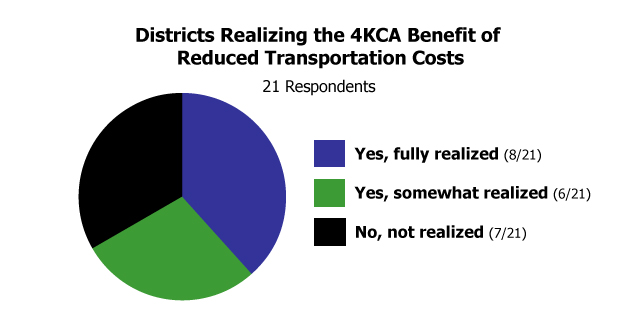
School districts in Wisconsin are obligated to provide transportation for four-year-old kindergarten at the same level they provide transportation for any other K-12 student. However, sometimes the school districts’ transportation expenses are reduced as a result of the 4K-Community Approach program. The community approach reduces the number of families that seek transportation from the school district if, for example, parents are unable to wait until 8:00 a.m. when the 4K session begins to place their child in child care or if they need to have their child receive after-school child care, they often transport their children themselves to and/or from the 4K site to take advantage of the wraparound care provided. Also, sometimes programs like Head Start transport children instead of having the schools provide the transportation thereby providing the school district with additional savings. Having parents and/or Head Start assume some of the responsibilities for transporting children saves the school district money.
Return to top
44. As a result of 4K Community Approach programs, special services are more accessible and provided earlier.
Natasha Harris, at Racine Unified School District, Jeff Bindl, School District of Reedsburg, and Heather Cramer at Stevens Point Area School District, talk about 4KCA and accessibility of special services.
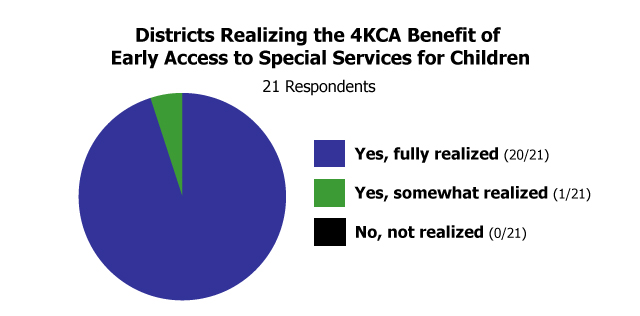
One result of the 4K-CA program has been increased contact between staff in the community sites and special education and other support staff (speech and language teachers, physical therapists, etc.) from the public schools. Sometimes, the school personnel visit the community programs specifically to work with four-year-olds. At other times, they work with younger children at the sites. In both instances, there is an increased presence of special services staff in the community sites, which results in several important benefits for school districts, including:
• Staff from the community sites are more willing and able to contact the school district about younger children for whom they have concerns because they get to know and trust the school’s special services staff and because they are more easily accessible (since they regularly visit the community sites). As a result, there’s an increase in referrals and early intervention services for younger children, whereas previously the sites often felt like they were entirely on their own figuring out how to best meet the needs of children with special needs.
• There is more outreach to parents as a result of the 4K-CA program and this results in an increase in the number of early interventions. Whereas previously the school district would primarily respond to calls from parents before doing an assessment, now the special services staff from the public schools and the staff from the 4K community venues are working together in identifying younger children warranting assessment.
• Parents learn more about special services through their contact with the community sites, and the community program staff in turn know more about the resources available and can access them more quickly through their increased contact with the public schools.
• Early intervention can reduce or even eliminate the need to provide special services for children when they get older, thereby providing significant financial benefits for school districts.
Return to top
45. The flexibility in program design provided by 4K Community Approach enables school districts to design unique programs to best meet the needs of their community.

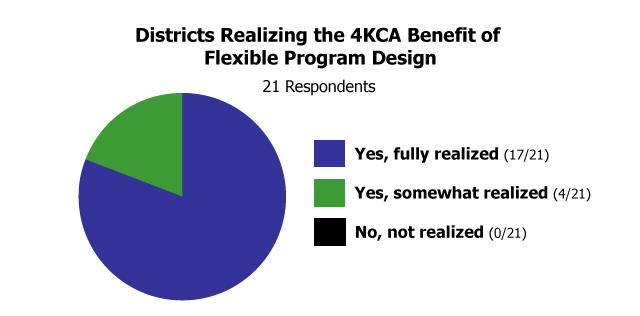
Within certain guidelines, the 4K Community Approach program allows school districts to flexibly design their four-year-old kindergarten programs to best meet the needs of their community. This understandably results in benefits which are unique to different communities.
Belinda Grantham, the Director of Early Education for the Kenosha Unified School District (KUSD), tells the unique story of the 4K Community Approach program in Kenosha,
“Background information:
Prior to the 2011-2012 school year, we had four options for children who were 3 and 4 years old in KUSD:
• Head Start
• Early Childhood – this is what we call our special education services
• P5-4K – P5 was a grant (preschool thru 5th grade) that low income schools received to provide additional services to increase student achievement. Having a 4K classroom in the school was required with the grant.
• 4K in childcare centers
Each of these programs were siloed. That version of programming resulted in minimal interaction between teachers who were teaching the same age level but in different programs. Because the program was the focus, there was not a common set of learning expectations or curriculum that was implemented---each program had their own. In addition, each program was only offered at certain locations limiting family options of where their child could attend for 4K, and, potentially, a child could attend 2-3 schools before they reached their kindergarten year at their neighborhood school.
Advantages of blending/braiding programming for KUSD:
• Children attend their neighborhood school from PreK – 5th grade. They attend where they live and the programming comes to them. As a result, in a single classroom you may have children and their families receiving special education services, Head Start services, and building services.
• Parents become integrated into their school’s culture one to two years sooner.
• Increased parent involvement in PreK classroom and school building (volunteering, attending school events, PTA/PTO, attending conferences, etc.)
• Braided funding saved seven 4K teaching positions that would have been cut with the end of the P-5 Grant.
• Integrating the programs also allowed a minimum of one Early Education classroom in every elementary school (there are 24 elementary schools)---when we stopped focusing on separate programs and integrated into one larger program, we were able to move teachers to buildings that previously did not offer Early Education.
• A common set of standards (WMELS) and a common curriculum and assessment tool are now used in all KUSD Early Ed classrooms. This includes the classrooms in the school buildings and in the childcare centers.
• Professional development is now able to be provided based on analysis of district wide assessment data.
• Standards for classrooms are based on the highest standard available, whether it be Head Start, IDEA, or DPI.
• To date, the purchase of additional materials has been minimal because special education classrooms had oodles of materials. With integration of special education and regular education, these oodles of materials have benefitted all.”
Return to top
 The
The  4K Community Approach program has opened new lines of communication between school district staff and staff in the community 4K settings. Experienced and knowledgeable child care teachers now share information about children they’ve sometimes known since birth with teachers of five-year-old kindergarten who will subsequently be teaching these same children. There are innumerable benefits resulting from such communications, including:
4K Community Approach program has opened new lines of communication between school district staff and staff in the community 4K settings. Experienced and knowledgeable child care teachers now share information about children they’ve sometimes known since birth with teachers of five-year-old kindergarten who will subsequently be teaching these same children. There are innumerable benefits resulting from such communications, including:








